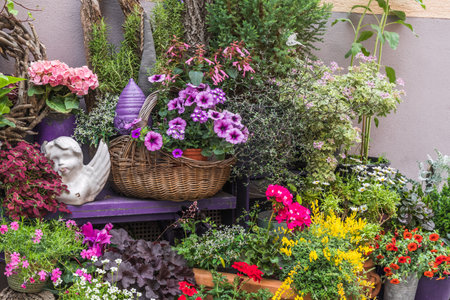Introduction: Growing Green in Small Spaces
City living often means trading sprawling backyards for cozy apartments and petite patios, but that doesn’t mean you have to give up on your gardening dreams. Container gardening is a smart, sustainable way to bring a little green into your life, no matter how limited your space may be. As urban areas across the United States continue to grow, so does the importance of conserving our most precious resources—especially water. With droughts becoming more frequent and environmental awareness on the rise, modern gardeners are looking for creative solutions that fit their lifestyles while making a positive impact. Container gardening not only allows you to maximize every inch of balcony, stoop, or windowsill, but it also offers unique opportunities to save water and reduce waste. In this series, we’ll explore how container gardening can transform small urban spaces into lush retreats while keeping conservation top of mind.
2. Choosing the Right Containers
When practicing container gardening with conservation in mind, your choice of containers plays a crucial role in both water and space efficiency. Urban balconies and patios often come with limited square footage, so selecting the right size and material is key to maximizing your green space without wasting resources.
Water-Wise Container Materials
The material of your container impacts how much water your plants retain or lose. Here’s a quick comparison:
| Material | Water Retention | Durability | Best For |
|---|---|---|---|
| Glazed Ceramic | High | Moderate-High | Drought-tolerant plants, sunny spots |
| Plastic/Resin | Very High | High | Tight spaces, lightweight needs |
| Terra Cotta (Unglazed) | Low | Moderate | Plants needing drier roots, cooler climates |
| Metal | Varies (depends on lining) | High but heats up fast | Herbs, short-term displays |
| Wood (with liner) | Moderate-High | Moderate (rot potential) | Larger plant groupings, rustic look |
Sizing for Small Spaces
If you’re gardening on an apartment balcony or a compact patio, opt for containers that make the most of vertical and horizontal space. Consider these tips:
- Tall Narrow Pots: Ideal for deep-rooted veggies and flowers without hogging floor area.
- Stackable Planters: Maximize growing room by going vertical—great for herbs and leafy greens.
- Window Boxes: Perfect for railing mountings, bringing color and food production to eye level.
- Slim Rectangular Troughs: Fit neatly along walls or railings while allowing multiple plants per box.
The Impact of Drainage on Water Conservation
A well-designed container garden balances healthy drainage with moisture retention. Too little drainage can drown roots, while too much can waste precious water. Choose containers with adjustable or moderate drainage holes and consider adding a saucer beneath pots to catch excess runoff for reuse. You can also line the bottom with gravel or repurposed materials to aid water flow while preventing loss.
Pro Tip: Self-Watering Options
If you have a busy city lifestyle, self-watering containers are a game-changer. They typically feature a reservoir at the base that minimizes evaporation and ensures roots access water as needed—saving time and conserving water simultaneously.
![]()
3. Smart Plant Selection for Water Efficiency
When space and water are at a premium, choosing the right plants is key to a successful, eco-friendly container garden. Opting for drought-tolerant and native species not only conserves resources but also ensures your urban oasis thrives with minimal fuss. Many American natives, such as succulents like Echeveria, compact varieties of Agave, or resilient grasses like Blue Fescue, are ideal for small containers on city balconies or patios. Herbs such as rosemary, thyme, and lavender also excel in limited spaces while requiring less frequent watering.
Why Native Plants Matter
Native plants are adapted to local climate conditions and typically need far less water than their exotic counterparts. In urban areas across the U.S., options like California poppy, black-eyed Susan, or coneflower bring vibrant color to container arrangements while supporting local pollinators. These plants not only help you save water but also contribute positively to the local ecosystem.
Compact Solutions for Small Spaces
Look for dwarf cultivars or naturally petite species that fit snugly in small pots and vertical planters. Sedum, hens-and-chicks, and even certain types of ornamental sage provide lush texture without sprawling out of control—perfect for maximizing every inch of your city balcony or patio.
Tips for Successful Container Growth
To get the best from your drought-tolerant selections, use high-quality potting mix designed for good drainage, and group plants with similar watering needs together. This approach minimizes waste and keeps maintenance simple, ensuring your conservation-minded container garden stays beautiful all season long.
Efficient Watering Techniques
Making the most of every drop is essential for eco-friendly container gardening, especially in urban settings where both water and space are precious. Here’s how you can keep your plants hydrated while conserving resources.
Smart Watering Schedules
Watering at the right time makes a significant difference. Early morning is ideal—the cooler air reduces evaporation, allowing roots to absorb more moisture. Avoid watering during the hottest part of the day or late evening to prevent water loss and fungal issues. Consistency is key; stick to a regular schedule that matches your local climate and plant needs.
Self-Watering Containers
Consider investing in self-watering containers. These pots feature a reservoir at the bottom, which provides a steady supply of moisture directly to the roots. This not only minimizes waste but also saves you time and effort. Check out this quick comparison:
| Type | Water Usage | Maintenance | Best For |
|---|---|---|---|
| Traditional Pots | Higher (frequent watering) | Medium | Low-maintenance plants |
| Self-Watering Containers | Lower (reservoir minimizes waste) | Low | Busy schedules, water-sensitive plants |
Mulching for Moisture Retention
A layer of mulch on top of your container soil does wonders for water conservation. Organic mulches like shredded bark, coconut coir, or even small pebbles help lock in moisture, reduce surface evaporation, and insulate roots against temperature swings.
Mulching Tips:
- Aim for a 1-2 inch layer on top of the soil.
- Avoid piling mulch against plant stems to prevent rot.
- Choose natural materials that break down over time, enriching the soil.
Quick Tip:
If you’re tight on space or budget, recycled newspaper strips or dried grass clippings work as simple DIY mulch alternatives.
5. Maximizing Space with Vertical and Multi-use Gardening
When every square foot counts, thinking vertically is the secret to turning a small balcony or patio into a lush urban oasis. Vertical gardening not only adds more greenery without eating up floor space, but it’s also a smart way to conserve water—plants stacked together often create microclimates that help retain moisture. Try wall-mounted planters, hanging pots, or even repurposed shoe organizers to grow herbs, leafy greens, or trailing flowers. Don’t overlook railings and fences; these are prime spots for attaching planters that bring life up to eye level.
Multi-use Containers: Double the Function, Double the Fun
If you’re working with limited room, look for containers that do more than just hold soil. Bench planters offer seating and garden space in one. Tiered plant stands allow you to layer different types of plants while taking up the footprint of a single pot. For a playful touch, use an old ladder as a vertical garden shelf—each rung can cradle a different potted herb or succulent.
Edible Arrangements: Grow Food and Beauty Together
Why not let your garden work overtime? Mixing edible plants like cherry tomatoes, basil, or strawberries into your containers not only saves trips to the grocery store but also brings fresh flavor right to your fingertips. Grouping companion plants—such as tomatoes with basil—can boost growth and minimize pests naturally, all while keeping your garden beautiful and productive.
Small-Scale Solutions for Urban Living
You don’t need sprawling suburban yards to enjoy homegrown goodness. Even a tiny balcony or sunny window ledge can host a thriving container garden when you stack smartly and choose multi-purpose solutions. With a little creativity, you’ll find there’s always room to grow greener—even in America’s most compact city spaces.
6. Eco-friendly Fertilizing and Maintenance
Creating a thriving container garden while conserving resources means choosing sustainable solutions for fertilizing and maintenance. In American urban settings, where space and water are precious, opting for eco-friendly fertilizers and adopting low-maintenance routines can make your balcony or patio oasis both lush and responsible.
Choose Organic and Slow-Release Fertilizers
Avoid synthetic chemicals by selecting organic fertilizers like compost, worm castings, or fish emulsion. These products enrich the soil naturally, support beneficial microbes, and reduce runoff pollution—perfect for tight city spaces where drainage can impact the environment. Slow-release fertilizers are another smart pick; they feed your plants gradually, minimizing waste and the need for frequent applications.
DIY Composting for Small Spaces
If you’re limited on room, try a compact vermicomposting bin right on your balcony. Food scraps turn into nutrient-rich compost without taking up much space. This not only cuts down on landfill waste but gives your container garden a steady supply of organic matter to boost plant health.
Smart Watering Routines
Water conservation is central to sustainable container gardening. Use mulch—like shredded bark or coconut coir—on top of your pots to retain moisture and keep roots cool. Water early in the morning to minimize evaporation, and group containers by water needs to avoid overwatering thirsty plants or drowning drought-tolerant ones.
Low-Maintenance Upkeep Tips
To save time and resources, select native or drought-tolerant plants that thrive in your local climate with minimal attention. Regularly check containers for pests or disease so you can spot-treat instead of resorting to broad-spectrum pesticides. Simple habits like deadheading spent flowers or trimming leggy growth help keep your urban garden vibrant without constant intervention.
By embracing these eco-friendly fertilizing methods and streamlined maintenance practices, you’ll nurture a green urban retreat that respects both your time and the environment—turning even the smallest balcony into a sustainable sanctuary.
7. Conclusion: Sustainable Urban Gardening Goals
Embracing container gardening with conservation in mind is more than a trend—its a lifestyle choice that empowers urban dwellers to make a real difference. By using water-saving techniques and maximizing every inch of available space, you contribute not just to your own well-being but also to the health of your city and the planet. Whether you have a sunny balcony in Brooklyn or a compact patio in LA, starting your own water-conscious container garden is an achievable goal. Every drought-tolerant herb, recycled planter, and carefully timed watering session adds up to a greener, smarter approach to urban living. Join the growing movement of city gardeners who are redefining sustainability one pot at a time. Your backyard or balcony can be both beautiful and resource-wise—so grab those containers and start planting today!

